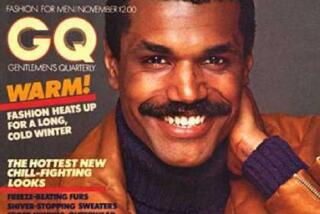From the Archives: Man of Thousand Faces Takes But One to Grave
Lon Chaney, beloved of millions throughout the world for his immortal portrayals on the motion-picture screen, will be borne to his lasting resting place tomorrow.
While his legions of friends and admirers within and without his chosen profession pause a moment to contemplate their loss, the body of the great character actor, who died in St. Vincent’s Hospital at 12:55 a.m. yesterday, will be entombed in Forest Lawn Memorial Park, Glendale, where the body of his father lies in another crypt.
The entombment, which will write the closing chapter to one of the most colorful careers in the history of American amusement, will follow brief services to be conducted at 2 p.m. in the Cunningham & O’Connor chapel, 1031 South Grand Avenue.
PALLBEARERS LISTED
The active pallbearers will be John Jeske, Clinton Lyle, R.L. Hinckley, Phil Epstein, William Dunphy and Claude I. Parker, and the honorary pallbearers, Louis B. Mayer, Nicholas Schenck, Irving G. Thalberg, Gen. Smedley D. Butler, Milton M. Cohen, Dr. John C. Webster, Hunt Stromberg, Paul Bern, Chester Vanderlip, M. E. Greenwood, Dr. Hugo A. Keifer, Tod Browning, Harry Carey, Lionel Barrymore, Ramon Navarro, William Haines, Lawrence Tibbett, Harry Rapf, Cliff Edwards, Dr. E. L. Commons, Jack Conway, George Hill, Henry Sharp, Fred Niblo, Edgar Selwyn, Benny Rubin, Fritz Tidden, Wallace Beery, Jack Benny, Sammy Lee, Pete Smith, Dr. Zeiler, James Dugan, Wallace Chewning, W. H. Hendry, H. Roy, Tom Gubbins, M. H. Newman, C. A. Locan, Jack Feinberg, Sam Feinberg, Merritt Gerstad and M. K. Wilson.
The mausoleum in which Mr. Chaney will sleep his last sleep in the shadow of the cross atop Forest Lawn is located in the section known as Dahlia Terrace. It comprises six crypts and was purchased by the actor on the death of his father, Frank H. Chaney, in April, 1927.
SHOCK TO FRIENDS
Mr. Chaney’s death came as a distinct shock to all who had watched and waited with bated breath as he waged a valiant fight for life since last Saturday, when three blood transfusions were resorted to in an effort to repel anemia resulting from an acute attack of lobar pneumonia. At intervals on Monday bulletins issued by his physicians stated he had rallied and appeared to be on the road to recovery.
Shortly after midnight, however, he was seized with a hemorrhage of the throat. He sank speedily into a coma and breathed his last before the arrival of his physicians. At his bedside when he died were his wife and Creighton Chaney, a son by a former marriage. The physicians later announced the direct cause of death was carcinoma of the bronchus.
MANY LAUD HIM
They called Lon Chaney “the man of a thousand face,” a phrase coined from his wide variety of roles he had assumed on the screen. And they were unanimous yesterday in voting him an unassailable niche in the hall of the screen’s immortals.
“It is with deep regret that we learned of his passing,” said “Uncle Carl” Laemmle, president of Universal Pictures, under whose banner the actor made his first bid for fame on the silver sheet. “At Universal City we saw him make a humble start and then reach the heights of a brilliant career in the two roles he best loved. He has passed from the ‘set’ but he is one of screendom’s real immortals, and we always will cherish the memory of his days with us.”
QUALITIES PRAISED
From his associates at Metro-Goldwyn-Mayer studios, where he was under contract at the time of his death, came eulogies by the score, couched in words sprung from deep and lasting love of the departed artist.
“His life will stand as an inspiration to all who aspire to achievement,” Louis B. Mayer said. “He was kindly, sympathetic, understanding—a friend of the friendless, blessed with a humanness seldom encountered in this modern day.”
Irving Thalberg called him “a great artist whose passing leaves a void none can fill;” and his words were echoed in the expressions of all others at the studio, from the lowliest to the mightiest.
MOURNING EVERYWHERE
A pall of sorrow enveloped the realm of motion pictures yesterday; and every “lot” was in mourning for its friend. Lon Chaney died in the very prime of his life and at the zenith of his extraordinary career. He was a few months more than 47 years of age. Born on April Fool’s Day (April 1) 1883, he started out in life as a mime; and by an odd twist of fate achieved one of the greatest successes of his career as a buffoon, namely, the heart-broken funny man in “Laugh, Clown, Laugh.”
Friends in Colorado Springs, his birthplace, yesterday were quoted as always having attributed Lon Chaney’s supreme artistry as a pantomimist to the fact that his parents were deaf mutes. They recalled that as a boy he found it necessary to combine facial expression with sign language in order to convey impressions to his father and mother. This, they contented, undoubtedly laid the foundation for the remarkable performances that were to follow in later life.
VARIED VENTURES
Mr. Chaney’s first venture in the theater was as a property boy in a Colorado Springs theater. When he was 17, he made his first public appearance as an actor, he and his brother playing an engagement as a comedy team. A year later he participated in a full-length play, produced for benefit of the state hands’ union. Between performances he helped install seats in a motion-picture theater, where thousands later hailed him for his striking portrayal of the grotesque role of Quasimodo in “The Hunchback of Notre Dame.”
Fired with ambition, Mr. Chaney and his brother, George, took their benefit play on the road, but its existence was short-lived, and Lon ultimately landed broke in Chicago. He took a fling at musical comedy without notable success, then came West, appearing with the Hartmann Opera Company in San Francisco and later with Kolb and Dill. In the Bay City he married Hazel Hastings, a member of the theatrical troupe, and she was his wife for twenty-two years.
STARTS AS “EXTRA”
It was back in 1912 that Mr. Chaney came to Hollywood and began his motion-picture career. He started as an extra in westerns produced at Universal City, and not long afterward was assigned to direct J. Warren Kerrigan. He guided the latter star through seven productions, then returned to acting, achieving screen credit for the first time in “Hell Morgan’s Girl,” an outstanding picture of its era, in which Dorothy Phillips was the star.
In 1919 Mr. Chaney was chosen by the late George Loane Tucker to play “The Frog” in “The Miracle Man,” and the performance he gave catapulted him overnight from obscurity to world-wide fame. He was regarded as occupying a unique position for his proven ability to distort his body in simulation of a hopeless cripple and to make up his face to resemble the most unearthly creatures imaginable as prescribed by the scenario writers. In short, he became as institution.
OTHER SUCCESSES
After “The Miracle Man” came “Outside the Law,” “The Trap,” “The Hunchback of Notre Dame,” “The Shock” and “The Phantom of the Opera,” in succession for Universal; and then “Treasure Island,” “The Penalty,” “Flesh and Blood,” “Oliver Twist,” “He Who Gets Slapped,” “Tower of Lies,” “The Monster,” “The Unholy Three,” “The Blackbird,” “The Road to Mandalay,” “Tell it to the Marines,” “Mr. Wu,” “The Unknown,” “Mockery,” “Laugh, Clown, Laugh,” “While the City Sleeps,” “West of Zanzibar,” “Thunder” and “Where East is East.”
With the advent of talking pictures, Mr. Chaney became one of the few “holdouts,” maintaining a tenacious loyalty to the silent screen for many months and declining to speak into the microphone. He finally was persuaded to give his voice to the screen, however, and his debut in the audible form of films was made recently in one of his greatest silent successes, “The Unholy Three.” Completing his performance he went to New York for treatment of the throat affliction which was to cause his death; and there contracted lobar pneumonia, which sapped his strength and rendered him a victim of anemia. It was to combat this malady that he entered St. Vincent’s Hospital last week.
HE LIVED SIMPLY
Mr. Chaney’s private life was one of considerable mystery. He shunned personal exhibitions, premiere showings, and interviews, telling intimates they were anathema to him, and although he reputedly possessed a fortune he live simply, foregoing pomp and servants. He was a prodigious reader and loved especially to pore over tomes on mathematical subjects. The chapter on screen make-up in the Encyclopedia Britannica was a contribution from his pen.
On the set he was gruff and acquired the name among those who did not know him well of being “hard-boiled;” yet once he scaled a precipitous roof to replace a baby bird in its nest. He is known to have contributed generously to numerous charities, though he never made publicity capital of his donations; and not one among his intimates but knew that his sympathies always were with the underdog in a struggle.
Besides his wife, brother and son, Mr. Chaney leaves an infant grandson. The son, Creighton, is in the water-heater business and lives at 735 North Laurel Avenue.
More to Read
Start your day right
Sign up for Essential California for the L.A. Times biggest news, features and recommendations in your inbox six days a week.
You may occasionally receive promotional content from the Los Angeles Times.






